Instructor Planning Guide
Activities
What activities are associated with this chapter?
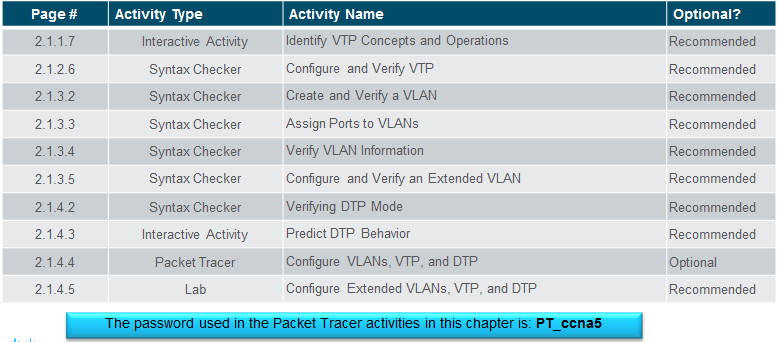

Assessment
Students should complete Chapter 2, “Assessment” after completing Chapter 2.
Quizzes, labs, Packet Tracers and other activities can be used to informally assess student progress.
Sections & Objectives
2.1 VTP, Extended VLANs, and DTP
Configure enhanced inter-switch connectivity technologies.
Compare VTP versions 1 and 2.
Configure VTP versions 1 and 2.
Configure extended VLANs.
Configure Dynamic Trunking Protocol (DTP).
2.2 Troubleshoot Multi-VLAN Issues
Troubleshoot issues in an inter-VLAN routing environment.
Troubleshoot common inter-VLAN configuration issues.
Troubleshoot common IP addressing issues in an inter-VLAN routed environment.
Troubleshoot common VTP and DTP issues in an inter-VLAN routed environment.
2.3 Layer 3 Switching
Implement inter-VLAN routing using Layer 3 switching to forward data in a small to medium-sized business LAN.
Configure inter-VLAN routing using Layer 3 switching.
Troubleshoot inter-VLAN routing in a Layer 3 switched environment.
Chapter 2: Scaling VLANs
2.1 – VTP, Extended VLANs, and DTP
2.1.1 – VTP Concepts and Operation
2.1.1.1 – VTP Overview
VLAN trunking protocol (VTP) allows a network administrator to manage VLANs on a switch configured as a VTP server.
The VTP server distributes and synchronizes VLAN information over trunk links to VTP-enabled switches throughout the switched network.
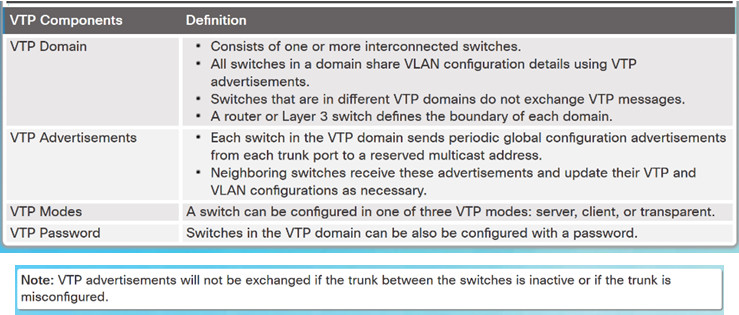
2.1.1.2 – VTP Modes
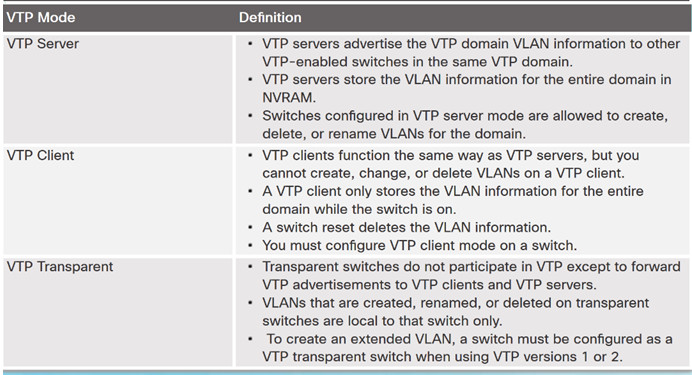
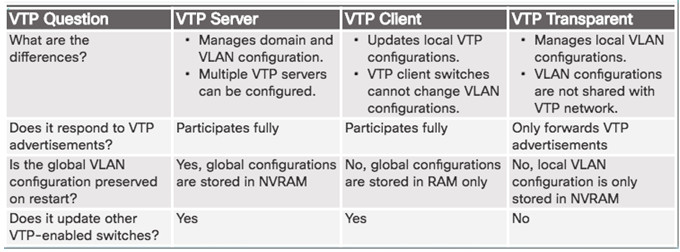
2.1.1.3 – VTP Advertisements
Three types of VTP Advertisements:
- Summary advertisements – contain VTP domain name and configuration revision number.
- Advertisement request – response to a summary advertisement message when the summary advertisement contains a higher configuration revision number than the current value.
- Subset advertisements – contain VLAN information including any changes.
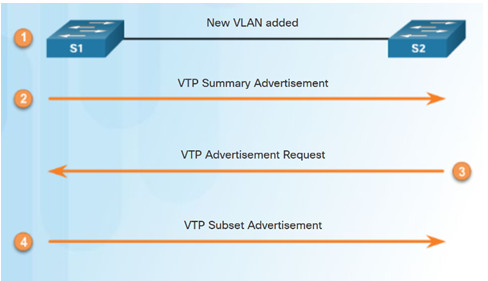
2.1.1.4 – VTP Versions
Switches in the same VTP domain must use the same VTP version.

Note: The newest version of VTP is Version 3, which is beyond the scope of this course.
2.1.1.5 – Default VTP configuration
The show vtp status command displays the VTP status which includes the following:
- VTP Version capable and running
- VTP Domain Name
- VTP Pruning Mode
- VTP Traps Generation
- Device ID
- Configuration Last Modified
- VTP Operating Mode
- Maximum VLANs Supported Locally
- Number of Existing VLANs
- Configuration Revision
- MD5 Digest
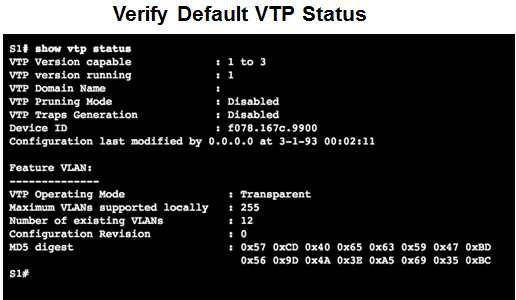
2.1.1.6 – VTP Caveats
VTP configuration revision number is stored in NVRAM.
To reset VTP configuration revision number to zero:
- Change the switch’s VTP domain to a nonexistent VTP domain and then change the domain back to the original name.
- Change the switch’s VTP mode to transparent and then back to previous VTP mode.
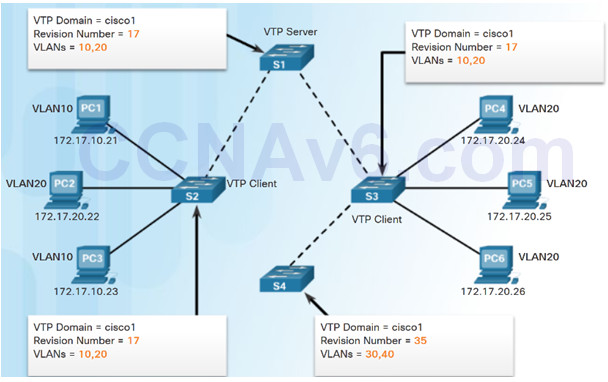
See graphic:
- S4 is added. The startup config has not been erased and VLAN.DAT file on S4 has not been deleted. S4 has the same VTP domain name configured as other two switches but its revision number is 35, which is higher than the revision number on the other two switches.
- S4 has VLAN 1 and is configured with VLAN 30 and 40. S4 does not have VLANs 10 and 20 in its database. Because S4 has a higher revision number, the rest of the switches in the domain will sync to S4’s revision.
- Consequence is VLANs 10 and 20 will no longer exist on the switches, leaving clients that are connected to ports belonging to those non-existing VLANs without connectivity.
2.1.2 – VTP Configuration
2.1.2.1 – VTP Configuration Overview
Steps to Configure VTP:
Step 1 – Configure the VTP Server
Step 2 – Configure the VTP Domain Name and Password
Step 3 – Configure the VTP Clients
Step 4 – Configure VLANs on the VTP Server.
Step 5 – Verify the VTP clients have received the new VLAN information.
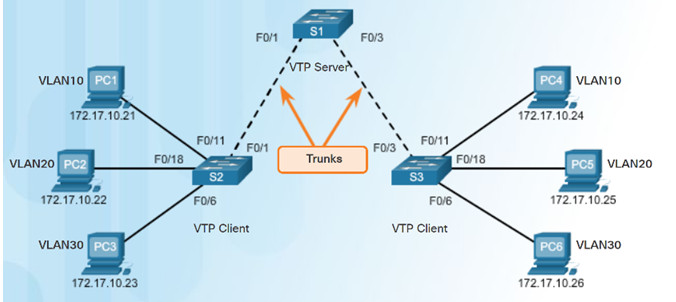
2.1.2.2 – Step 1 – Configure the VTP Server
Use the vtp mode server command to configure a switch as a VTP server.
- Confirm all switches are configured with default configuration before issuing this command to avoid problems with configuration revision numbers.
Use the show vtp status to verify.
- Notice configuration revision number is still set to 0 and number of existing VLANS is 5.
- The 5 VLANs are the default VLAN 1 and VLANs 1002-1005.
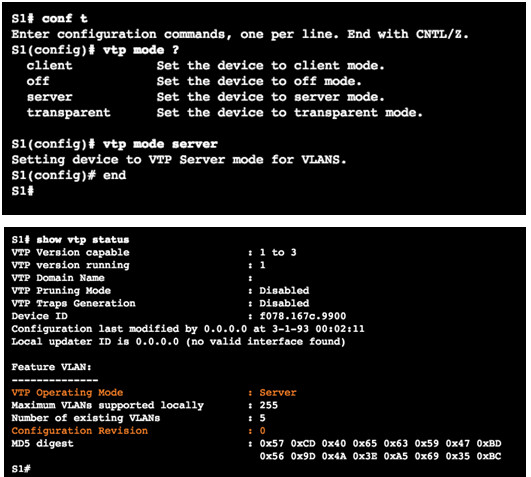
2.1.2.3 – Step 2 – Configure the VTP Domain Name and Password
Use the vtp domain domain-name command to configure the domain name.
- VTP client must have same domain name as the VTP server before it will accept VTP advertisements.
Configure a password using the vtp password password command.
- Use the show vtp password command to verify.
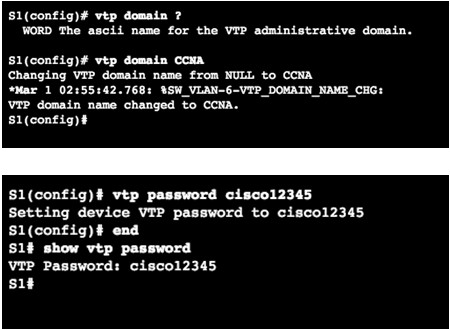
2.1.2.4 – Step 3 – Configure the VTP Clients

Use the vtp mode client command to configure the VTP clients.
Use same domain name and password as VTP server.
2.1.2.5 – Step 4 – Configure VLANs on the VTP Server
Use the vlan vlan-number command to create VLANs.
Use show vlan brief to verify the VLANs.
Use show vtp status to verify server status.
- Every time a VLAN is added the configuration register is incremented


2.1.2.6– Step 5 – Verify that the VTP Clients Have Received the New VLAN Information
Use the show vlan brief command to verify that the client received the new VLAN information.
Verify client status using the show vtp status command.
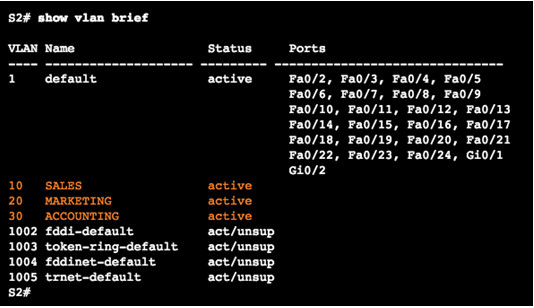
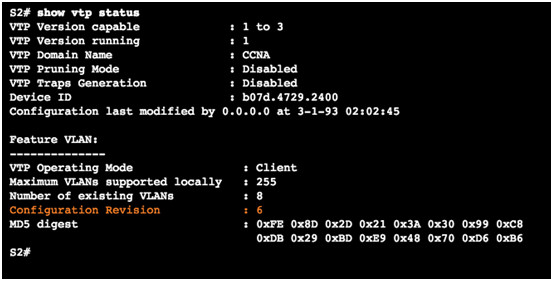
2.1.3 – Extended VLANs
2.1.3.1 – VLAN Ranges on Catalyst Switches
Catalyst 2960 and 3560 Series switches support over 4,000 VLANs.
Normal range VLANs are numbered 1 to 1,005.
- Stored in vlan.dat file
Extended range VLANs are numbered 1,006 to 4,094.
- Not stored in vlan.dat file
- VTP does not learn
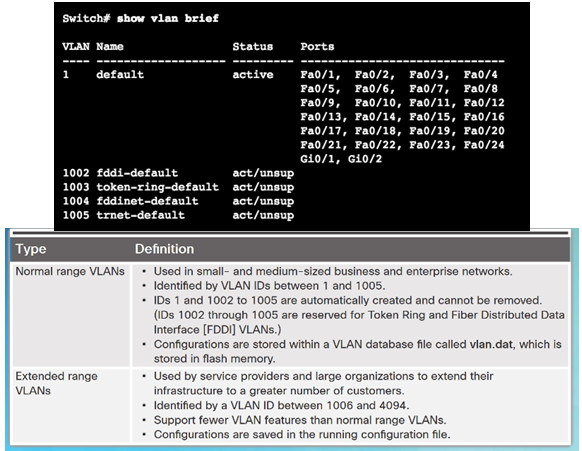
2.1.3.2 – Creating a VLAN
Normal range VLANs are stored in flash in vlan.dat
Use vlan vlan-id to create a VLAN
- Use name vlan-name to name the VLAN
- Naming each VLAN is considered a best practice in switch configuration.
To configure multiple VLANs, a series of VLAN IDs can be entered separated by commas, or a range of VLAN IDs separated by hyphens.
- vlan 100,102,105-107

2.1.3.3 – Assigning Ports to VLANs
Access port can belong to only one VLAN at a time.
- Only exception is when an IP phone is connected to the port. Then there are two VLANs associated with the port: one for voice and one for data.
Note: Use the interface range command to simultaneously configure multiple interfaces.
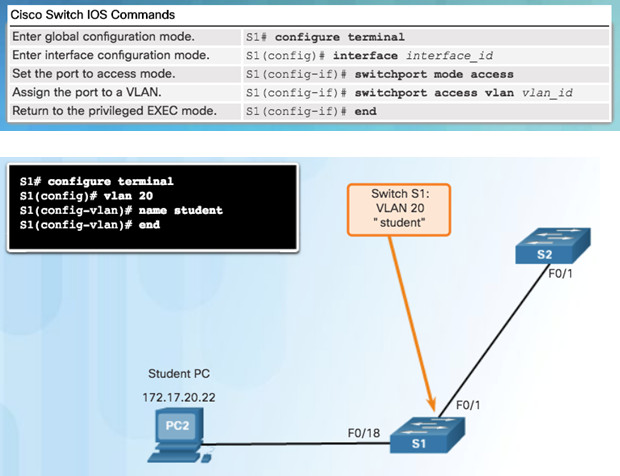
2.1.3.4 – Verifying VLAN Information
Commands to verify VLANs:
- show vlan
- show interfaces
- show vlan name vlan-name
- show vlan brief
- show vlan summary
- show interfaces vlan vlan-id
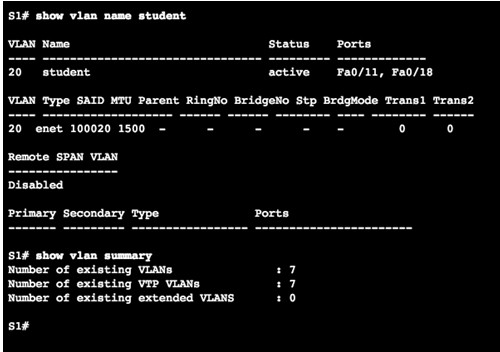
2.1.3.5 – Configuring Extended VLANs
Extended range VLANs are identified by a VLAN ID between 1006 and 4094.
To configure an extended VLAN on a 2960 switch it must be set to VTP transparent mode. (By default 2960 switches do not support Extended range VLANs.)
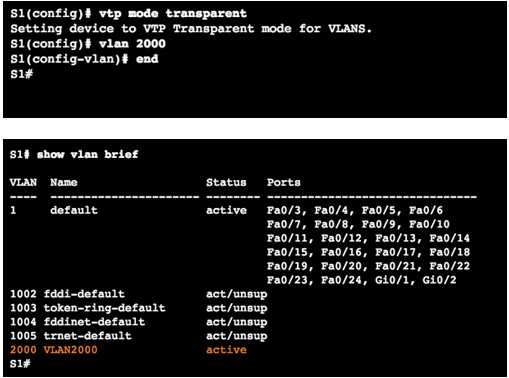
2.1.4 – Dynamic Trunking Protocol
2.1.4.1 – Introduction to DTP
Trunk negotiation is managed by the Dynamic Trunking Protocol (DTP)
- DTP is a Cisco proprietary protocol
- automatically enabled on Catalyst 2960 and Catalyst 3560 Series switches.
To enable trunking from a Cisco switch to a device that does not support DTP, use the switchport mode trunk and switchport nonegotiate
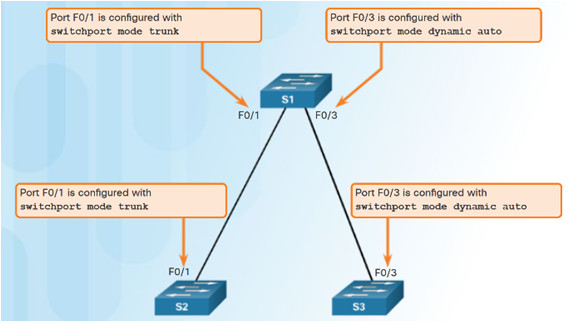

2.1.4.2 – Negotiated Interface Modes
Different trunking modes:
- Switchport mode access – interface becomes a nontrunk interface.
- Switchport mode dynamic auto – interface becomes a trunk if the neighboring interface is set to trunk or desirable mode.
- Switchport mode dynamic desirable – interface becomes a trunk if the neighboring interface is set to trunk, desirable, or dynamic auto mode.
- Switchport mode trunk – interface becomes a trunk even if the neighboring interface is not a trunk interface.
- Switchport nonegotiate – prevents the interface from generating DTP frames.
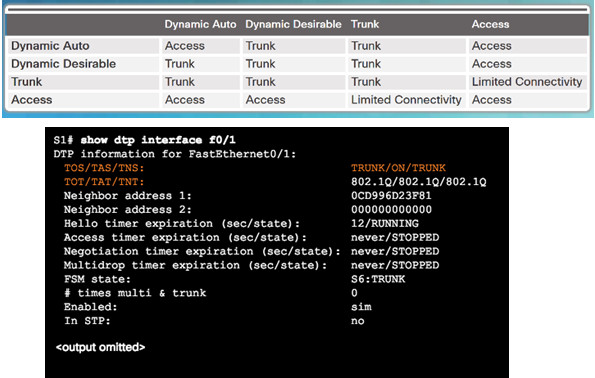
- Configure trunk links statically whenever possible.
- Use show dtp interface to verify DTP.
2.1.4.4 – Packet Tracer – Configure VTP and DTP
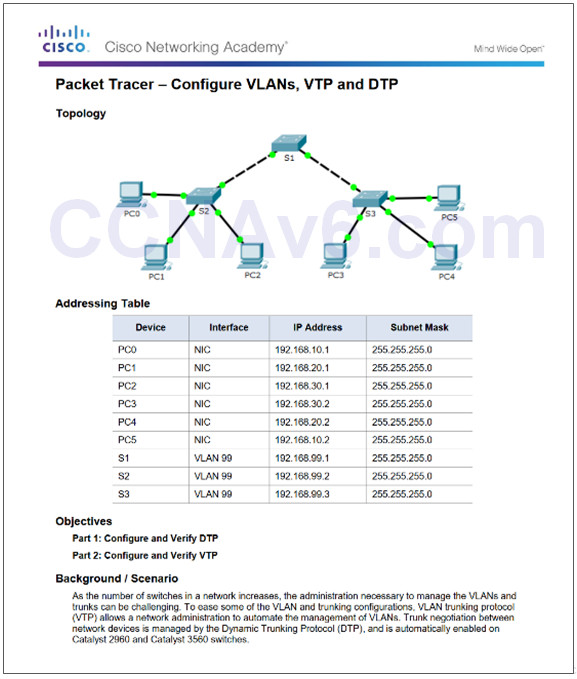
2.1.4.4 Packet Tracer – Configure VLANs, VTP, and DTP
2.1.4.5 – Lab – Configure Extended VLANs, VTP and DTP
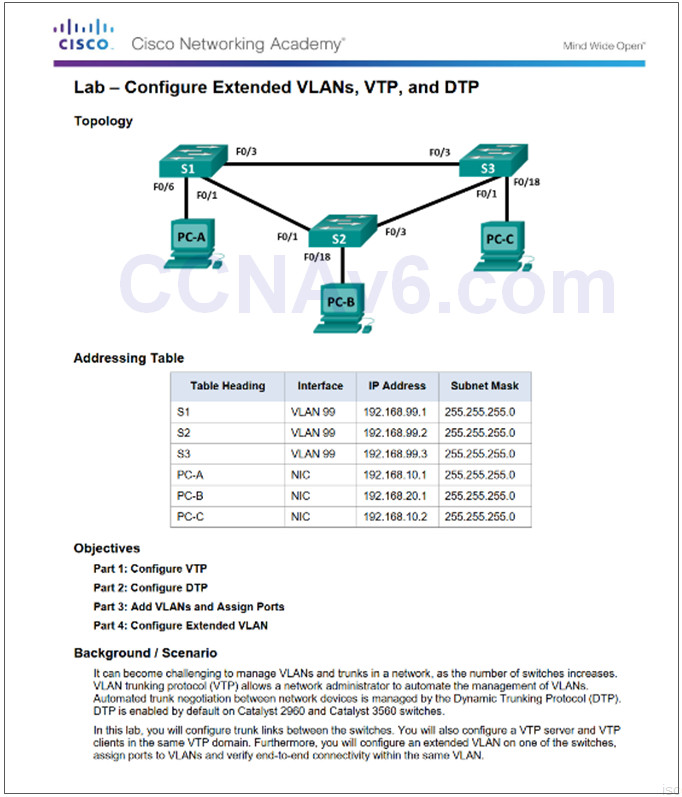
2.1.4.5 Lab – Configure Extended VLANs, VTP, and DTP
2.2 – Troubleshoot Multi-VLAN Issues
2.2.1 – Inter-VLAN Configuration Issues
2.2.1.1 –Deleting VLANs
- Deleting a VLAN from a switch that is in VTP server mode removes the VLAN from all switches in the VTP domain.
Note: You cannot delete the default VLANs (i.e., VLAN 1, 1002 – 1005).
- Use the no vlan vlan-id global configuration mode command to delete a VLAN.
- Any ports assigned to that VLAN become inactive. They remain inactive until assigned to a new VLAN.

2.2.1.2 –Switch Port Issues
When using the legacy routing model for inter-VLAN routing, the switch ports connected to the router interfaces must be configured with the correct VLANs.
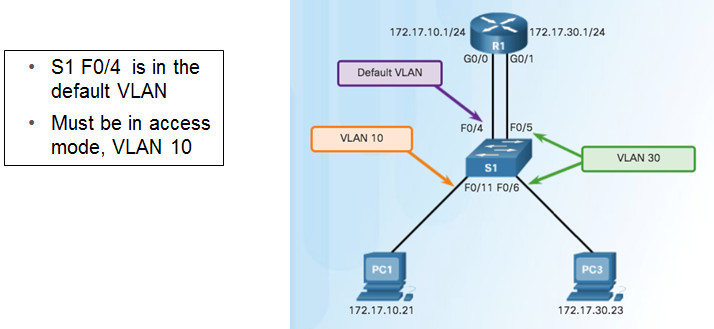
When using the router-on-a-stick routing model the interface on the switch connected to the router must be configured as a trunk port.
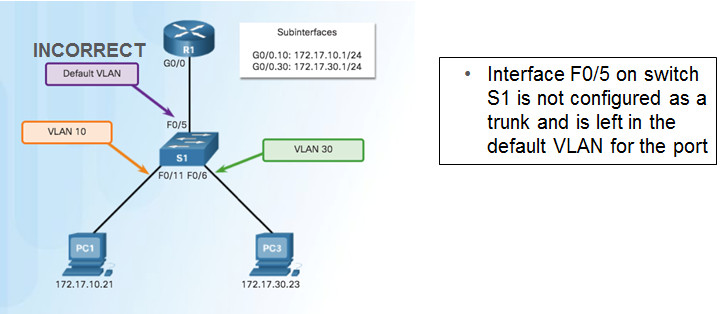
2.2.1.3 –Verify Switch Configuration
Commands to verify switch configuration:
- show interfaces interface-id switchport
- show running-config
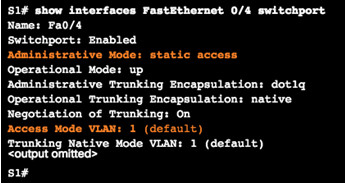
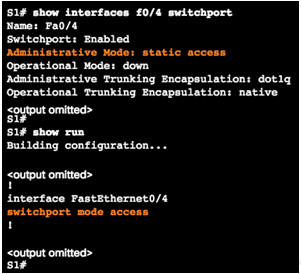
2.2.1.4 –Interface Issues
When enabling inter-VLAN routing on a router, one of the most common configuration errors is to connect the physical router interface to the wrong switch port.
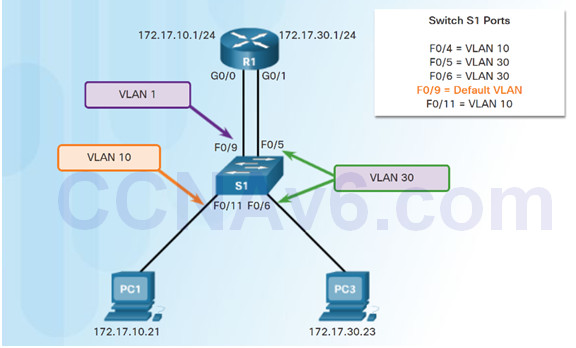
2.2.1.5 –Verify Routing Configuration
With router-on-a-stick configurations, a common problem is assigning the wrong VLAN ID to the subinterface.
Use show interfaces and the show running-config commands to verify the routing configurations.
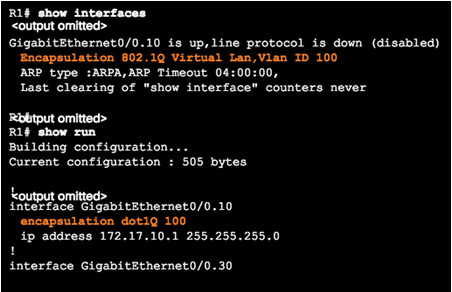
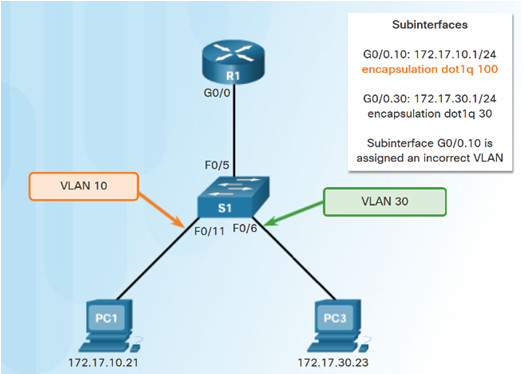
2.2.2 – IP Addressing Issues
2.2.2.1 – Errors with IP Addresses and Subnet Masks
For inter-VLAN routing to operate, a router must be connected to all VLANs, either by separate physical interfaces or by subinterfaces.
Each interface, or subinterface, must be assigned an IP address that corresponds to the subnet to which it is connected.
Each PC must be configured with an IP address within the VLAN it is assigned to.
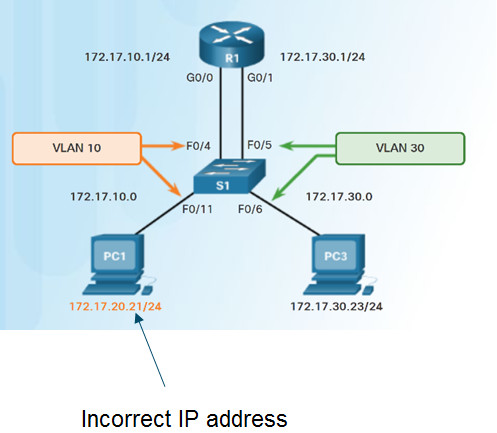
2.2.2.2 – Verifying IP Address and Subnet Mask Configuration Issues
A common error is to incorrectly configure an IP address for a subinterface.
- Use show run and show ip interface to verify IP addressing.
Another error is incorrectly addressing the end device.
- Use ipconfig to verify the address on a Windows PC
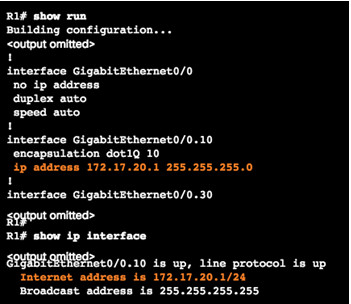
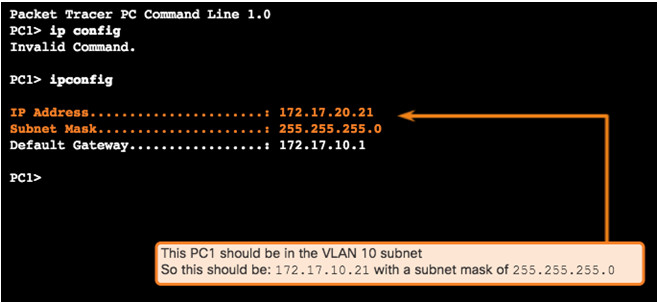
2.2.2.4 – Packet Tracer – Troubleshooting Inter-VLAN Routing
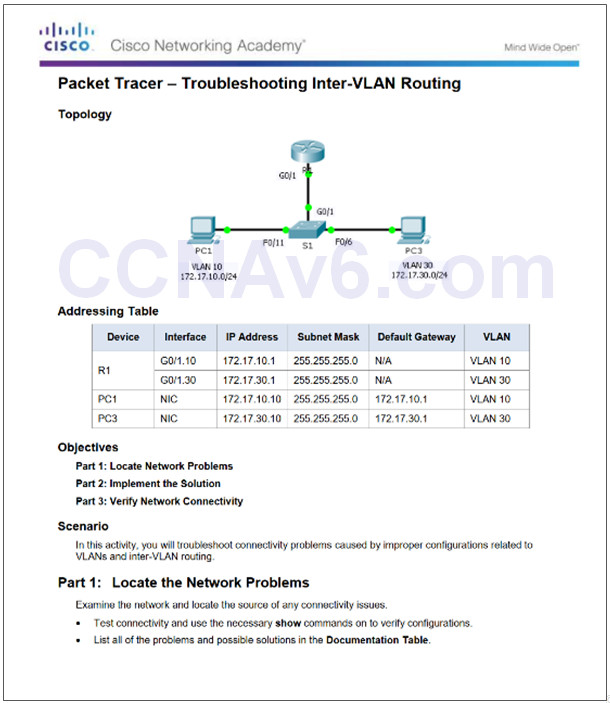
2.2.2.4 Packet Tracer – Troubleshooting Inter-VLAN Routing
2.2.2.5 – Lab – Troubleshooting Inter-VLAN Routing
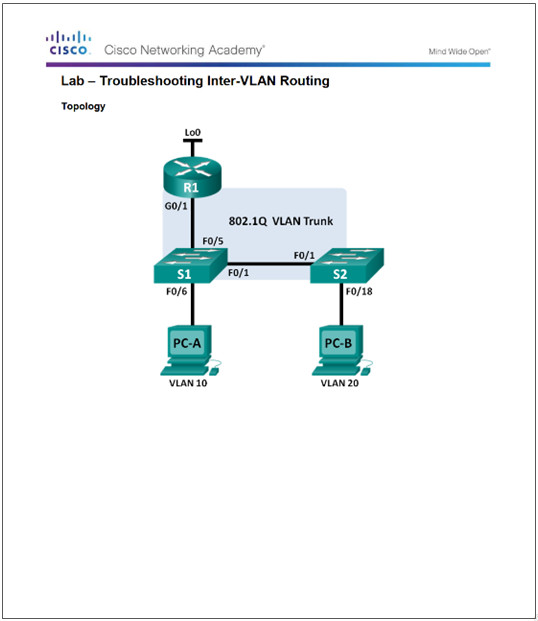
2.2.2.5 Lab – Troubleshooting Inter-VLAN Routing
2.2.3 – VTP and DTP Issues
2.2.3.1 – Troubleshoot VTP Issues

2.2.3.2 – Troubleshoot DTP Issues
Common Problems with Trunks
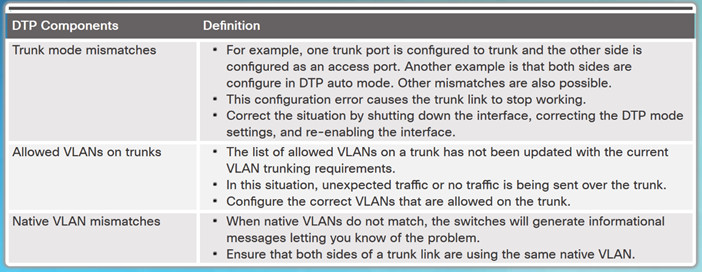
2.2.3.3 – Packet Tracer – Troubleshoot VTP and DTP Issues
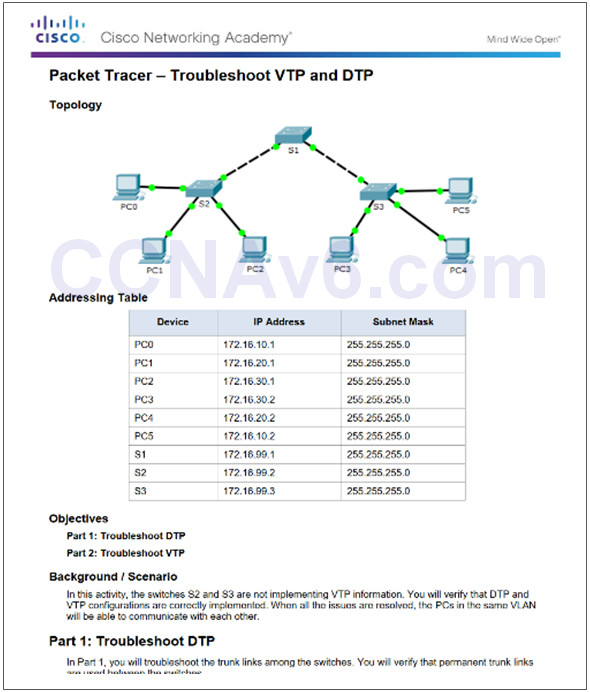
2.2.3.3 Packet Tracer – Troubleshoot VTP and DTP
2.3 – Layer 3 Switching
2.3.1 – Layer 3 Switching Operation and Configuration
2.3.1.1 – Introduction to Layer 3 Switching
Multilayer switches provide high-packet processing rates using hardware-based switching.
Catalyst multilayer switches support the following types of Layer 3 interfaces:
- Routed port – A layer 3 interface
- Switch virtual interface (SVI) – Virtual Interface for inter- VLAN routing
All Layer 3 Cisco Catalyst switches support routing protocols, but several models require enhanced software for specific routing protocol features.
Catalyst 2960 Series switches running IOS 12.2(55) or later, support static routing.

2.3.1.2 – Inter-VLAN Routing with Switch Virtual Interfaces
In the early days of switched networks, switching was fast and routing was slow. Therefore the layer 2 switching portion was extended as much as possible into the network.
Now routing can be performed at wire speed, and is performed at both the distribution and core layers.
Distribution switches are configured as Layer 3 gateways using Switch Virtual Interfaces (SVIs) or routed ports.
Routed ports are usually implemented between the distribution and core layers.
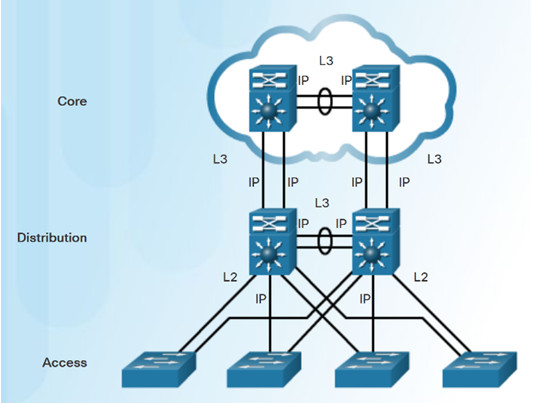
2.3.1.3 – Inter-VLAN Routing with Switch Virtual Interfaces (Cont.)
An SVI is a virtual interface that is configured within a multilayer switch:
- To provide a gateway for a VLAN so that traffic can be routed into or out of that VLAN.
- To provide Layer 3 IP connectivity to the switch.
- To support routing protocol and bridging configurations.
Advantages of SVIs:
- Faster than router-on-a-stick.
- No need for external links from the switch to the router for routing.
- Not limited to one link. Layer 2 EtherChannels can be used to get more bandwidth.
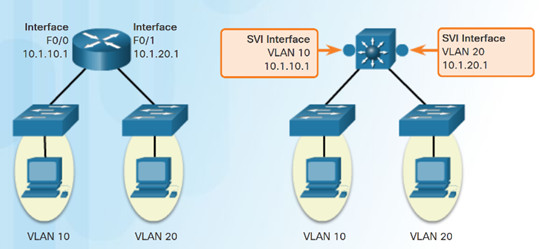
2.3.1.4 – Inter-VLAN Routing with Routed Ports
A routed port is a physical port that acts similarly to an interface on a router:
- It is not associated with a particular VLAN.
- It does not support subinterfaces.
Routed ports are primarily configured between switches in the core and distribution layer.
Use the no switchport interface command on the appropriate port to configure a routed port.
Note: Routed ports are not supported on Catalyst 2960 Series switches.
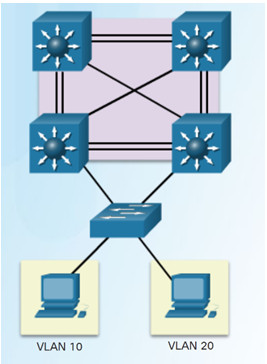
2.3.1.5 – Packet Tracer – Configure Layer 3 Switching and Inter-VLAN routing
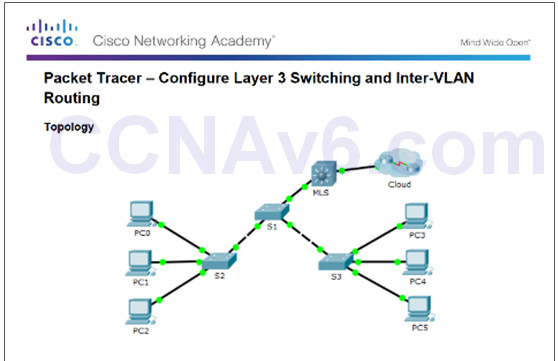
2.3.1.5 Packet Tracer – Configure Layer 3 Switching and inter-VLAN Routing
2.3.2 – Troubleshoot Layer 3 Switching
2.3.2.1 – Layer 3 Switch Configuration Issues
To troubleshoot Layer 3 switching issues check the following:
- VLANs – verify correct configuration.
- SVIs – verify correct IP, subnet mask and VLAN number.
- Routing – verify that either static or dynamic routing is correctly configured and enabled.
- Hosts – verify correct IP, subnet mask, and default gateway.
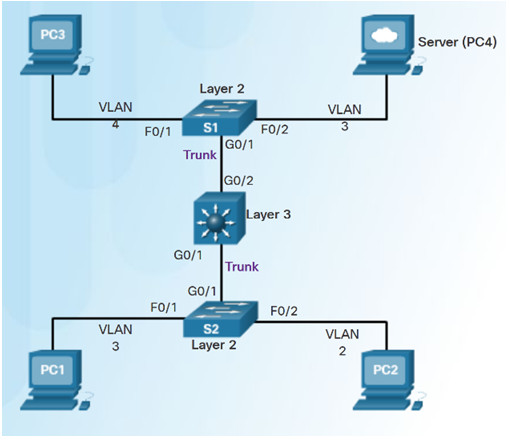
2.3.2.2 – Example: Troubleshooting Layer 3 Switching
There are four steps to implementing a new VLAN:
- Step 1. Create and name a new VLAN 500 on the fifth floor switch and on the distribution switches.
- Step 2. Add ports to VLAN 500 and ensure that the trunk is set up between distribution switches.
- Step 3. Create an SVI interface on the distribution switches and ensure that IP addresses are assigned.
- Step 4. Verify connectivity.
The troubleshooting plan checks for the following:
- Step 1. Verify that all VLANs have been created.
- Step 2. Ensure that ports are in the right VLAN and trunking is working as expected.
- Step 3. Verify SVI configurations.
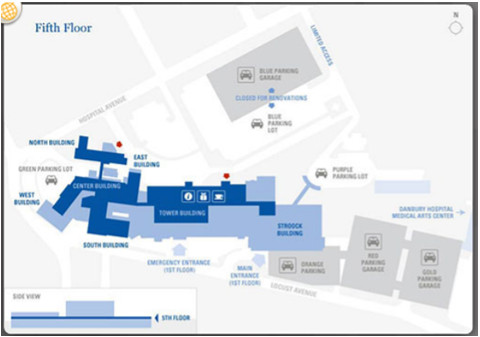
2.3 – Summary
2.3.1 – Conclusion
2.3.1.1 – Chapter 2: Scaling VLANs
Configure enhanced inter-switch connectivity technologies.
Troubleshoot issues in an inter-VLAN routing environment.
Implement inter-VLAN routing using Layer 3 switching to forward data in a small to medium-sized business LAN.
New Terms and Commands
| •virtual local area networks (VLANs)
•trunks •VLAN Trunking Protocol (VTP) •Dynamic Trunking Protocol (DTP) •extended range VLANs •vlan.dat •VTP Domain •VTP Advertisements •VTP Modes •VTP Server •VTP Client •VTP Transparent •Summary advertisements •Advertisement request |
•Subset advertisements
•normal range VLANs •inter-VLAN routing •legacy inter-VLAN routing •router-on-a-stick inter-VLAN routing •Layer 3 inter-VLAN routing •Routed port •Switch Virtual Interface (SVI) •Cisco Express Forwarding |

thanks